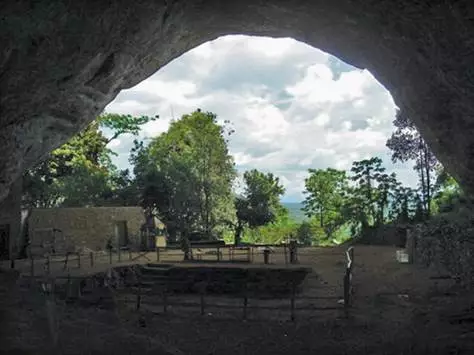论文标题:Specialized rainforest hunting by Homo sapiens ~45,000 years ago
期刊:Nature Communications
作者:Oshan Wedage, Noel Amano, Michelle C. Langley, Katerina Douka, James Blinkhorn, Alison Crowther, Siran Deraniyagala, Nikos Kourampas, Ian Simpson, Nimal Perera, Andrea Picin, Nicole Boivin, Michael Petraglia, Patrick Roberts
发表时间:2019/02/19
数字识别码: 10.1038/s41467-019-08623-1
原文链接:http://t.cn/EVFhj9c
微信链接:https://mp.weixin.qq.com/s/3o1fwRq1jfQjnIJMqab2Xw
本周《自然-通讯》在线发表的一篇论文Specialized rainforest hunting by Homo sapiens ~45,000 years ago指出,斯里兰卡已知最早的智人中,有一些很擅长狩猎半树栖和树栖的猴子及松鼠。这一发现说明,猎获行踪难觅的小型哺乳动物是智人可塑性行为的一部分,这些行为让智人得以在其他古人类近亲未曾立足的一系列极端环境中迅速定居。

图1:左:松鼠跟骨显示不同程度的灼烧痕迹;右:从斯里兰卡Fa-Hien Lena洞穴中复原的用猴子骨头和牙齿制作的工具。图源:N. Amano
从晚更新世(距今12.6-1.17万年)开始,人类从非洲向外扩散后曾在各种环境中生活过,但热带雨林被认为是人类扩散的一道屏障,因为这些环境中缺少巨型哺乳类动物。但是,斯里兰卡、东南亚和美拉尼西亚发现的关于人类定居的最早证据常常与热带雨林环境有关。由于缺少详尽的动物区系分析,科学家并不了解当时人类赖以为生的是什么食物,以及使用了什么狩猎策略。

图2:Fa-Hien Lena洞穴入口。图源:O. Wedage
德国马克斯•普朗克人类历史学研究所的Patrick Roberts和同事运用多项技术对斯里兰卡一处年代最早的考古遗址Fa-Hien Lena洞穴(此前年代测定为距今3.8万年)进行了分析。作者发现,住在这里的智人在约4.5万年到3千年前,能够运用复杂的骨器和细石器(小型石制工具)捕获灵长类动物和巨型松鼠。由于这些动物极易成为过度狩猎的对象,作者因此认为,能够利用这些动物的古人类较为熟悉它们的生命周期和活动区域,并采取了可持续的狩猎策略。

图3:Semnopithecus priam是在Fa-Hien Lena洞穴定居的早期人类的猎物之一。
图源:O. Wedage
摘要:Defining the distinctive capacities of Homo sapiens relative to other hominins is a major focus for human evolutionary studies. It has been argued that the procurement of small, difficult-to-catch, agile prey is a hallmark of complex behavior unique to our species; however, most research in this regard has been limited to the last 20,000 years in Europe and the Levant. Here, we present detailed faunal assemblage and taphonomic data from Fa-Hien Lena Cave in Sri Lanka that demonstrates specialized, sophisticated hunting of semi-arboreal and arboreal monkey and squirrel populations from ca. 45,000 years ago, in a tropical rainforest environment. Facilitated by complex osseous and microlithic technologies, we argue these data highlight that the early capture of small, elusive mammals was part of the plastic behavior of Homo sapiens that allowed it to rapidly colonize a series of extreme environments that were apparently untouched by its hominin relatives.
阅读论文全文请访问:http://t.cn/EVFhj9c
期刊介绍:Nature Communications (https://www.nature.com/ncomms/) is an open access journal that publishes high-quality research from all areas of the natural sciences. Papers published by the journal represent important advances of significance to specialists within each field.
The 2017 journal metrics for Nature Communications are as follows:
•2-year impact factor: 12.353
•5-year impact factor: 13.691
•Immediacy index: 1.829
•Eigenfactor® score: 0.92656
•Article Influence Score: 5.684
(来源:科学网)
特别声明:本文转载仅仅是出于传播信息的需要,并不意味着代表本网站观点或证实其内容的真实性;如其他媒体、网站或个人从本网站转载使用,须保留本网站注明的“来源”,并自负版权等法律责任;作者如果不希望被转载或者联系转载稿费等事宜,请与我们接洽。